Chanho Eom
Leveraging Prior Knowledge of Diffusion Model for Person Search
Oct 02, 2025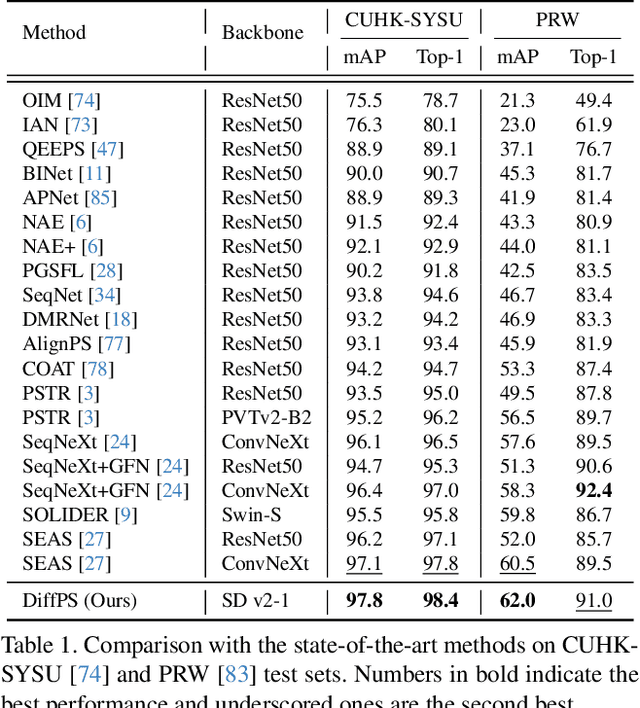

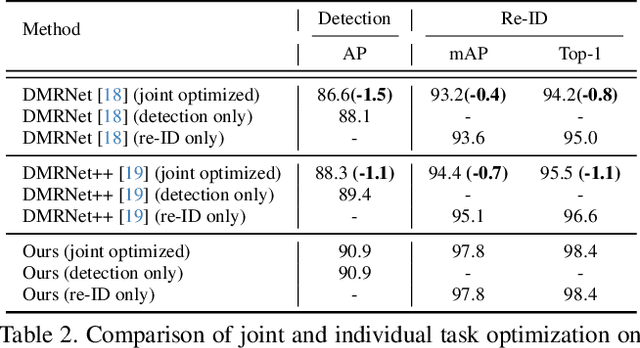

Abstract:Person search aims to jointly perform person detection and re-identification by localizing and identifying a query person within a gallery of uncropped scene images. Existing methods predominantly utilize ImageNet pre-trained backbones, which may be suboptimal for capturing the complex spatial context and fine-grained identity cues necessary for person search. Moreover, they rely on a shared backbone feature for both person detection and re-identification, leading to suboptimal features due to conflicting optimization objectives. In this paper, we propose DiffPS (Diffusion Prior Knowledge for Person Search), a novel framework that leverages a pre-trained diffusion model while eliminating the optimization conflict between two sub-tasks. We analyze key properties of diffusion priors and propose three specialized modules: (i) Diffusion-Guided Region Proposal Network (DGRPN) for enhanced person localization, (ii) Multi-Scale Frequency Refinement Network (MSFRN) to mitigate shape bias, and (iii) Semantic-Adaptive Feature Aggregation Network (SFAN) to leverage text-aligned diffusion features. DiffPS sets a new state-of-the-art on CUHK-SYSU and PRW.
Visual Representation Alignment for Multimodal Large Language Models
Sep 09, 2025Abstract:Multimodal large language models (MLLMs) trained with visual instruction tuning have achieved strong performance across diverse tasks, yet they remain limited in vision-centric tasks such as object counting or spatial reasoning. We attribute this gap to the prevailing text-only supervision paradigm, which provides only indirect guidance for the visual pathway and often leads MLLMs to discard fine-grained visual details during training. In this paper, we present VIsual Representation ALignment (VIRAL), a simple yet effective regularization strategy that aligns the internal visual representations of MLLMs with those of pre-trained vision foundation models (VFMs). By explicitly enforcing this alignment, VIRAL enables the model not only to retain critical visual details from the input vision encoder but also to complement additional visual knowledge from VFMs, thereby enhancing its ability to reason over complex visual inputs. Our experiments demonstrate consistent improvements across all tasks on widely adopted multimodal benchmarks. Furthermore, we conduct comprehensive ablation studies to validate the key design choices underlying our framework. We believe this simple finding opens up an important direction for the effective integration of visual information in training MLLMs.
MoCHA-former: Moiré-Conditioned Hybrid Adaptive Transformer for Video Demoiréing
Aug 21, 2025Abstract:Recent advances in portable imaging have made camera-based screen capture ubiquitous. Unfortunately, frequency aliasing between the camera's color filter array (CFA) and the display's sub-pixels induces moir\'e patterns that severely degrade captured photos and videos. Although various demoir\'eing models have been proposed to remove such moir\'e patterns, these approaches still suffer from several limitations: (i) spatially varying artifact strength within a frame, (ii) large-scale and globally spreading structures, (iii) channel-dependent statistics and (iv) rapid temporal fluctuations across frames. We address these issues with the Moir\'e Conditioned Hybrid Adaptive Transformer (MoCHA-former), which comprises two key components: Decoupled Moir\'e Adaptive Demoir\'eing (DMAD) and Spatio-Temporal Adaptive Demoir\'eing (STAD). DMAD separates moir\'e and content via a Moir\'e Decoupling Block (MDB) and a Detail Decoupling Block (DDB), then produces moir\'e-adaptive features using a Moir\'e Conditioning Block (MCB) for targeted restoration. STAD introduces a Spatial Fusion Block (SFB) with window attention to capture large-scale structures, and a Feature Channel Attention (FCA) to model channel dependence in RAW frames. To ensure temporal consistency, MoCHA-former performs implicit frame alignment without any explicit alignment module. We analyze moir\'e characteristics through qualitative and quantitative studies, and evaluate on two video datasets covering RAW and sRGB domains. MoCHA-former consistently surpasses prior methods across PSNR, SSIM, and LPIPS.
Domain Generalization for Person Re-identification: A Survey Towards Domain-Agnostic Person Matching
Jun 14, 2025Abstract:Person Re-identification (ReID) aims to retrieve images of the same individual captured across non-overlapping camera views, making it a critical component of intelligent surveillance systems. Traditional ReID methods assume that the training and test domains share similar characteristics and primarily focus on learning discriminative features within a given domain. However, they often fail to generalize to unseen domains due to domain shifts caused by variations in viewpoint, background, and lighting conditions. To address this issue, Domain-Adaptive ReID (DA-ReID) methods have been proposed. These approaches incorporate unlabeled target domain data during training and improve performance by aligning feature distributions between source and target domains. Domain-Generalizable ReID (DG-ReID) tackles a more realistic and challenging setting by aiming to learn domain-invariant features without relying on any target domain data. Recent methods have explored various strategies to enhance generalization across diverse environments, but the field remains relatively underexplored. In this paper, we present a comprehensive survey of DG-ReID. We first review the architectural components of DG-ReID including the overall setting, commonly used backbone networks and multi-source input configurations. Then, we categorize and analyze domain generalization modules that explicitly aim to learn domain-invariant and identity-discriminative representations. To examine the broader applicability of these techniques, we further conduct a case study on a related task that also involves distribution shifts. Finally, we discuss recent trends, open challenges, and promising directions for future research in DG-ReID. To the best of our knowledge, this is the first systematic survey dedicated to DG-ReID.
Subnet-Aware Dynamic Supernet Training for Neural Architecture Search
Mar 13, 2025Abstract:N-shot neural architecture search (NAS) exploits a supernet containing all candidate subnets for a given search space. The subnets are typically trained with a static training strategy (e.g., using the same learning rate (LR) scheduler and optimizer for all subnets). This, however, does not consider that individual subnets have distinct characteristics, leading to two problems: (1) The supernet training is biased towards the low-complexity subnets (unfairness); (2) the momentum update in the supernet is noisy (noisy momentum). We present a dynamic supernet training technique to address these problems by adjusting the training strategy adaptive to the subnets. Specifically, we introduce a complexity-aware LR scheduler (CaLR) that controls the decay ratio of LR adaptive to the complexities of subnets, which alleviates the unfairness problem. We also present a momentum separation technique (MS). It groups the subnets with similar structural characteristics and uses a separate momentum for each group, avoiding the noisy momentum problem. Our approach can be applicable to various N-shot NAS methods with marginal cost, while improving the search performance drastically. We validate the effectiveness of our approach on various search spaces (e.g., NAS-Bench-201, Mobilenet spaces) and datasets (e.g., CIFAR-10/100, ImageNet).
Cerberus: Attribute-based person re-identification using semantic IDs
Dec 02, 2024Abstract:We introduce a new framework, dubbed Cerberus, for attribute-based person re-identification (reID). Our approach leverages person attribute labels to learn local and global person representations that encode specific traits, such as gender and clothing style. To achieve this, we define semantic IDs (SIDs) by combining attribute labels, and use a semantic guidance loss to align the person representations with the prototypical features of corresponding SIDs, encouraging the representations to encode the relevant semantics. Simultaneously, we enforce the representations of the same person to be embedded closely, enabling recognizing subtle differences in appearance to discriminate persons sharing the same attribute labels. To increase the generalization ability on unseen data, we also propose a regularization method that takes advantage of the relationships between SID prototypes. Our framework performs individual comparisons of local and global person representations between query and gallery images for attribute-based reID. By exploiting the SID prototypes aligned with the corresponding representations, it can also perform person attribute recognition (PAR) and attribute-based person search (APS) without bells and whistles. Experimental results on standard benchmarks on attribute-based person reID, Market-1501 and DukeMTMC, demonstrate the superiority of our model compared to the state of the art.
Disentangled Representations for Short-Term and Long-Term Person Re-Identification
Sep 09, 2024
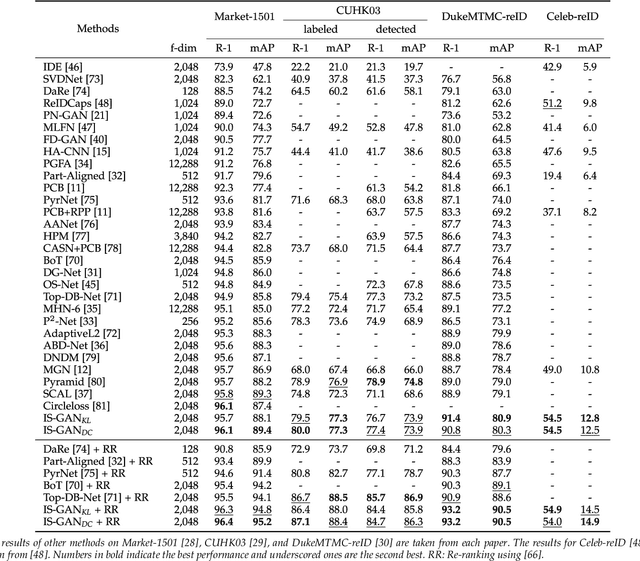

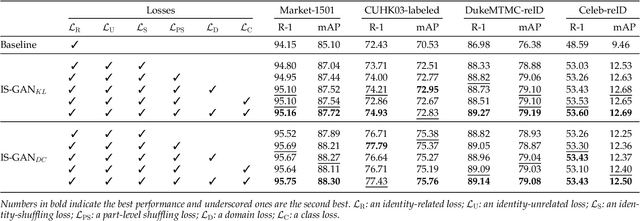
Abstract:We address the problem of person re-identification (reID), that is, retrieving person images from a large dataset, given a query image of the person of interest. A key challenge is to learn person representations robust to intra-class variations, as different persons could have the same attribute, and persons' appearances look different, e.g., with viewpoint changes. Recent reID methods focus on learning person features discriminative only for a particular factor of variations (e.g., human pose), which also requires corresponding supervisory signals (e.g., pose annotations). To tackle this problem, we propose to factorize person images into identity-related and unrelated features. Identity-related features contain information useful for specifying a particular person (e.g., clothing), while identity-unrelated ones hold other factors (e.g., human pose). To this end, we propose a new generative adversarial network, dubbed identity shuffle GAN (IS-GAN). It disentangles identity-related and unrelated features from person images through an identity-shuffling technique that exploits identification labels alone without any auxiliary supervisory signals. We restrict the distribution of identity-unrelated features or encourage the identity-related and unrelated features to be uncorrelated, facilitating the disentanglement process. Experimental results validate the effectiveness of IS-GAN, showing state-of-the-art performance on standard reID benchmarks, including Market-1501, CUHK03, and DukeMTMC-reID. We further demonstrate the advantages of disentangling person representations on a long-term reID task, setting a new state of the art on a Celeb-reID dataset.
* arXiv admin note: substantial text overlap with arXiv:1910.12003
Bi-directional Contrastive Learning for Domain Adaptive Semantic Segmentation
Jul 22, 2022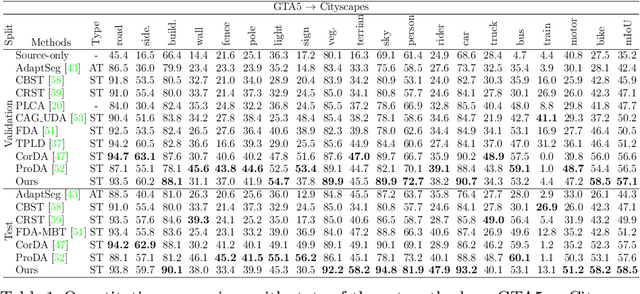

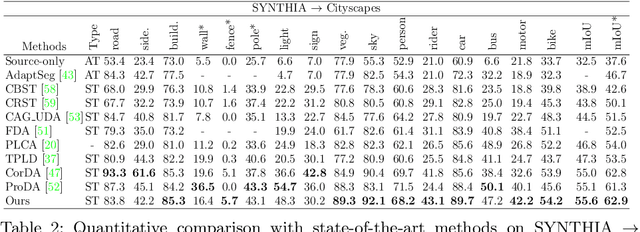

Abstract:We present a novel unsupervised domain adaptation method for semantic segmentation that generalizes a model trained with source images and corresponding ground-truth labels to a target domain. A key to domain adaptive semantic segmentation is to learn domain-invariant and discriminative features without target ground-truth labels. To this end, we propose a bi-directional pixel-prototype contrastive learning framework that minimizes intra-class variations of features for the same object class, while maximizing inter-class variations for different ones, regardless of domains. Specifically, our framework aligns pixel-level features and a prototype of the same object class in target and source images (i.e., positive pairs), respectively, sets them apart for different classes (i.e., negative pairs), and performs the alignment and separation processes toward the other direction with pixel-level features in the source image and a prototype in the target image. The cross-domain matching encourages domain-invariant feature representations, while the bidirectional pixel-prototype correspondences aggregate features for the same object class, providing discriminative features. To establish training pairs for contrastive learning, we propose to generate dynamic pseudo labels of target images using a non-parametric label transfer, that is, pixel-prototype correspondences across different domains. We also present a calibration method compensating class-wise domain biases of prototypes gradually during training.
Video-based Person Re-identification with Spatial and Temporal Memory Networks
Aug 20, 2021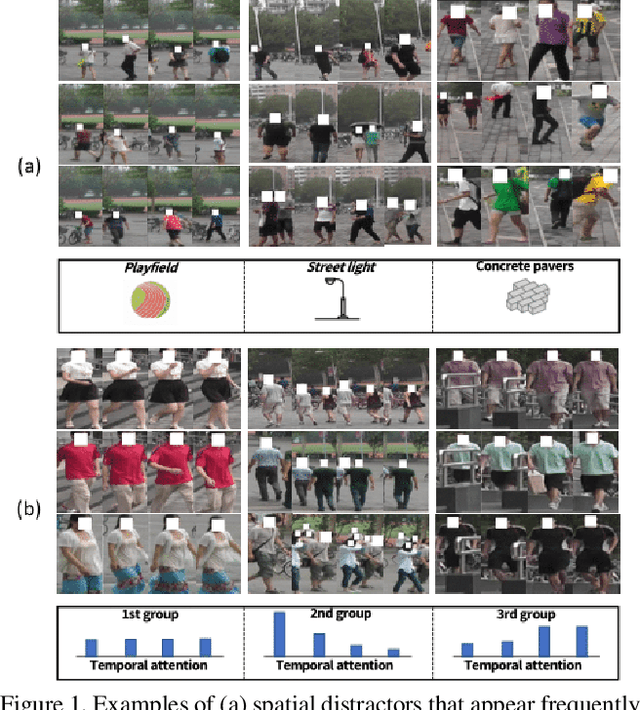
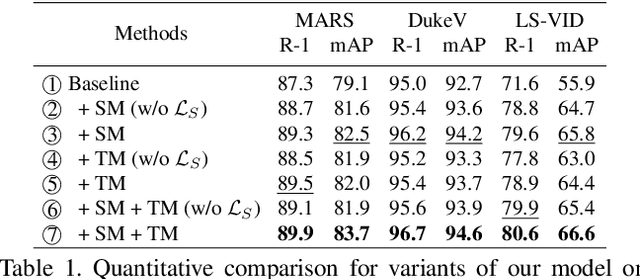
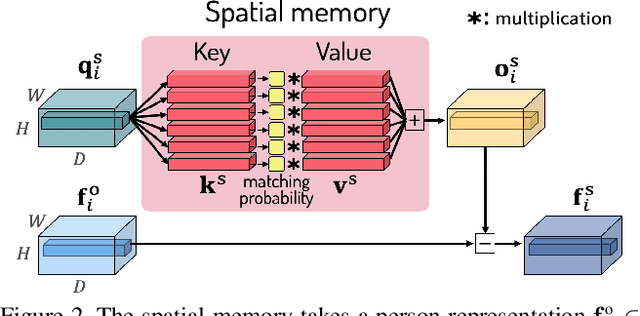
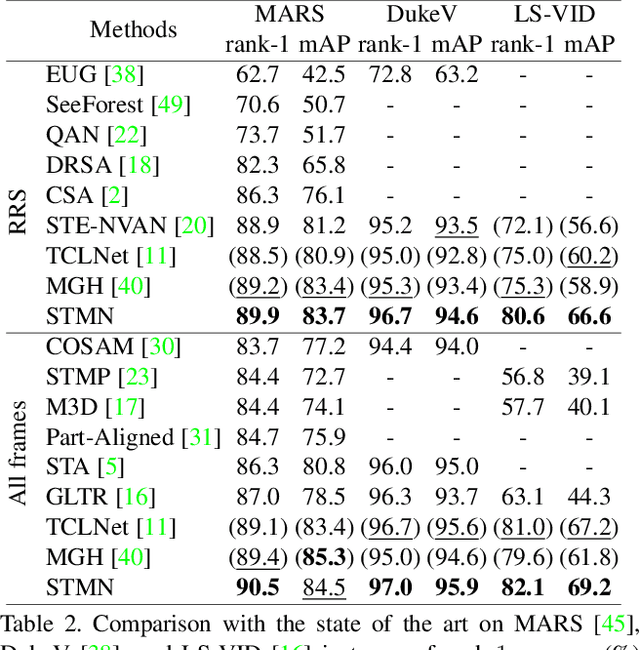
Abstract:Video-based person re-identification (reID) aims to retrieve person videos with the same identity as a query person across multiple cameras. Spatial and temporal distractors in person videos, such as background clutter and partial occlusions over frames, respectively, make this task much more challenging than image-based person reID. We observe that spatial distractors appear consistently in a particular location, and temporal distractors show several patterns, e.g., partial occlusions occur in the first few frames, where such patterns provide informative cues for predicting which frames to focus on (i.e., temporal attentions). Based on this, we introduce a novel Spatial and Temporal Memory Networks (STMN). The spatial memory stores features for spatial distractors that frequently emerge across video frames, while the temporal memory saves attentions which are optimized for typical temporal patterns in person videos. We leverage the spatial and temporal memories to refine frame-level person representations and to aggregate the refined frame-level features into a sequence-level person representation, respectively, effectively handling spatial and temporal distractors in person videos. We also introduce a memory spread loss preventing our model from addressing particular items only in the memories. Experimental results on standard benchmarks, including MARS, DukeMTMC-VideoReID, and LS-VID, demonstrate the effectiveness of our method.
Learning Disentangled Representation for Robust Person Re-identification
Nov 01, 2019
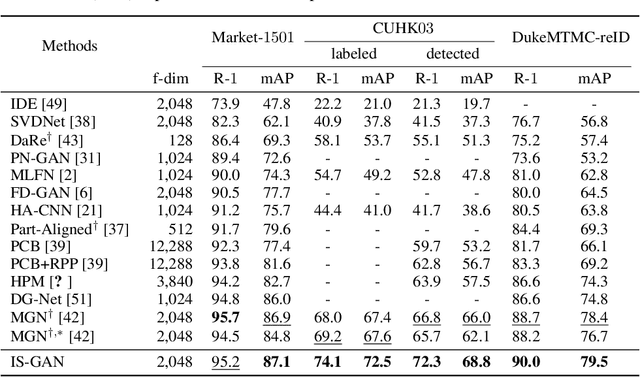


Abstract:We address the problem of person re-identification (reID), that is, retrieving person images from a large dataset, given a query image of the person of interest. A key challenge is to learn person representations robust to intra-class variations, as different persons can have the same attribute and the same person's appearance looks different with viewpoint changes. Recent reID methods focus on learning discriminative features but robust to only a particular factor of variations (e.g., human pose), which requires corresponding supervisory signals (e.g., pose annotations). To tackle this problem, we propose to disentangle identity-related and -unrelated features from person images. Identity-related features contain information useful for specifying a particular person (e.g., clothing), while identity-unrelated ones hold other factors (e.g., human pose, scale changes). To this end, we introduce a new generative adversarial network, dubbed \emph{identity shuffle GAN} (IS-GAN), that factorizes these features using identification labels without any auxiliary information. We also propose an identity-shuffling technique to regularize the disentangled features. Experimental results demonstrate the effectiveness of IS-GAN, significantly outperforming the state of the art on standard reID benchmarks including the Market-1501, CUHK03 and DukeMTMC-reID. Our code and models are available online: https://cvlab-yonsei.github.io/projects/ISGAN/.
 Add to Chrome
Add to Chrome Add to Firefox
Add to Firefox Add to Edge
Add to Edge